Analysis of Australia's Macroeconomic Performance (1995-2015)
VerifiedAdded on 2023/01/23
|14
|4190
|34
Report
AI Summary
This report evaluates the macroeconomic performance of the Australian economy from 1995 to 2015, analyzing key indicators such as real GDP, inflation, unemployment, interest rates, exchange rates, and the cash rate. It examines the relationships between real GDP growth, inflation, and unemployment, exploring business cycle fluctuations and the influence of the US economy. The analysis includes summary statistics, graphical representations, and discussions on monetary and fiscal policies. The report also investigates the relationship between net exports and exchange rates, and the impact of the Federal funds rate on the Australian cash rate. Finally, the report provides an economic outlook for Australia, based on past performance, and concludes with recommendations.
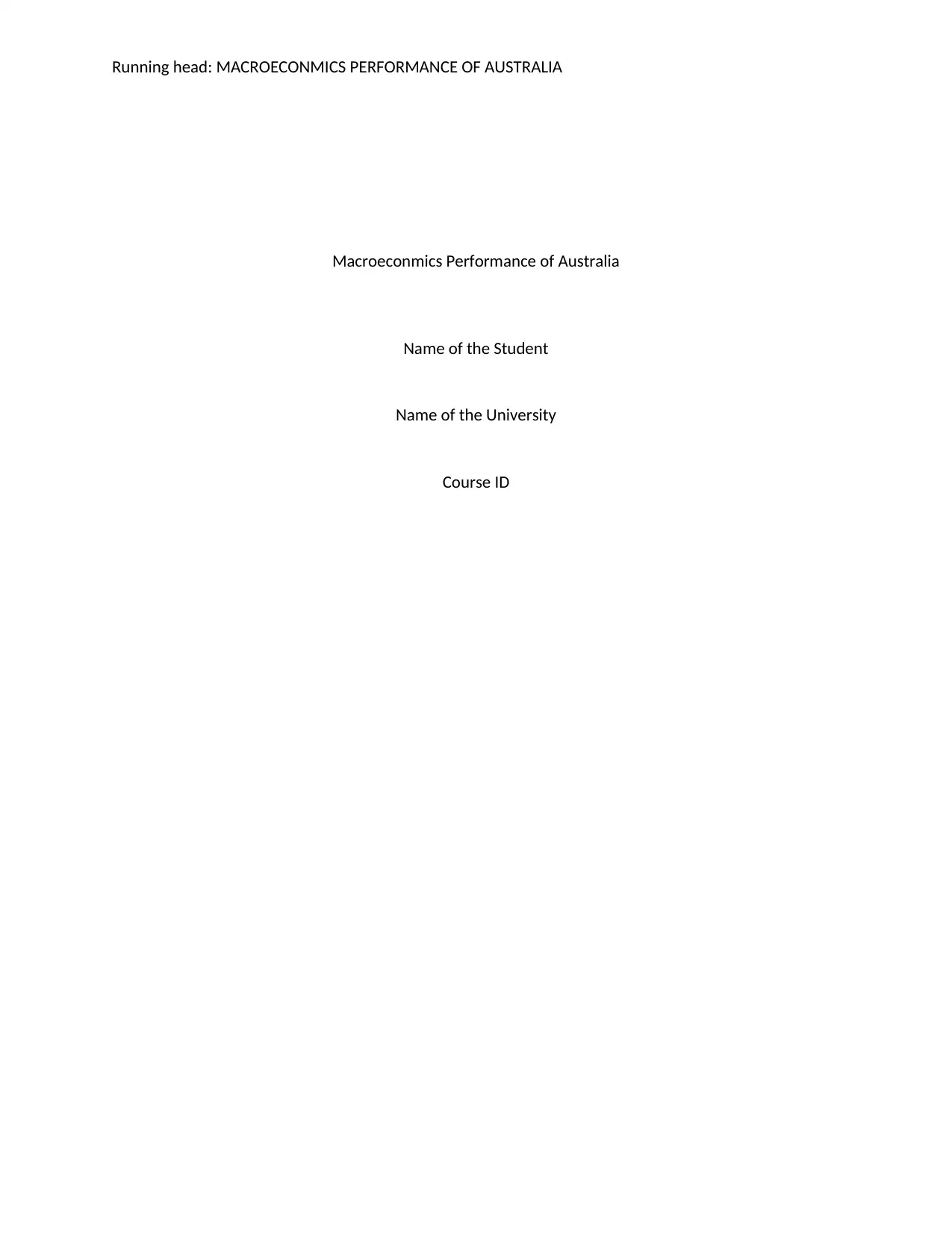
Running head: MACROECONMICS PERFORMANCE OF AUSTRALIA
Macroeconmics Performance of Australia
Name of the Student
Name of the University
Course ID
Macroeconmics Performance of Australia
Name of the Student
Name of the University
Course ID
Paraphrase This Document
Need a fresh take? Get an instant paraphrase of this document with our AI Paraphraser
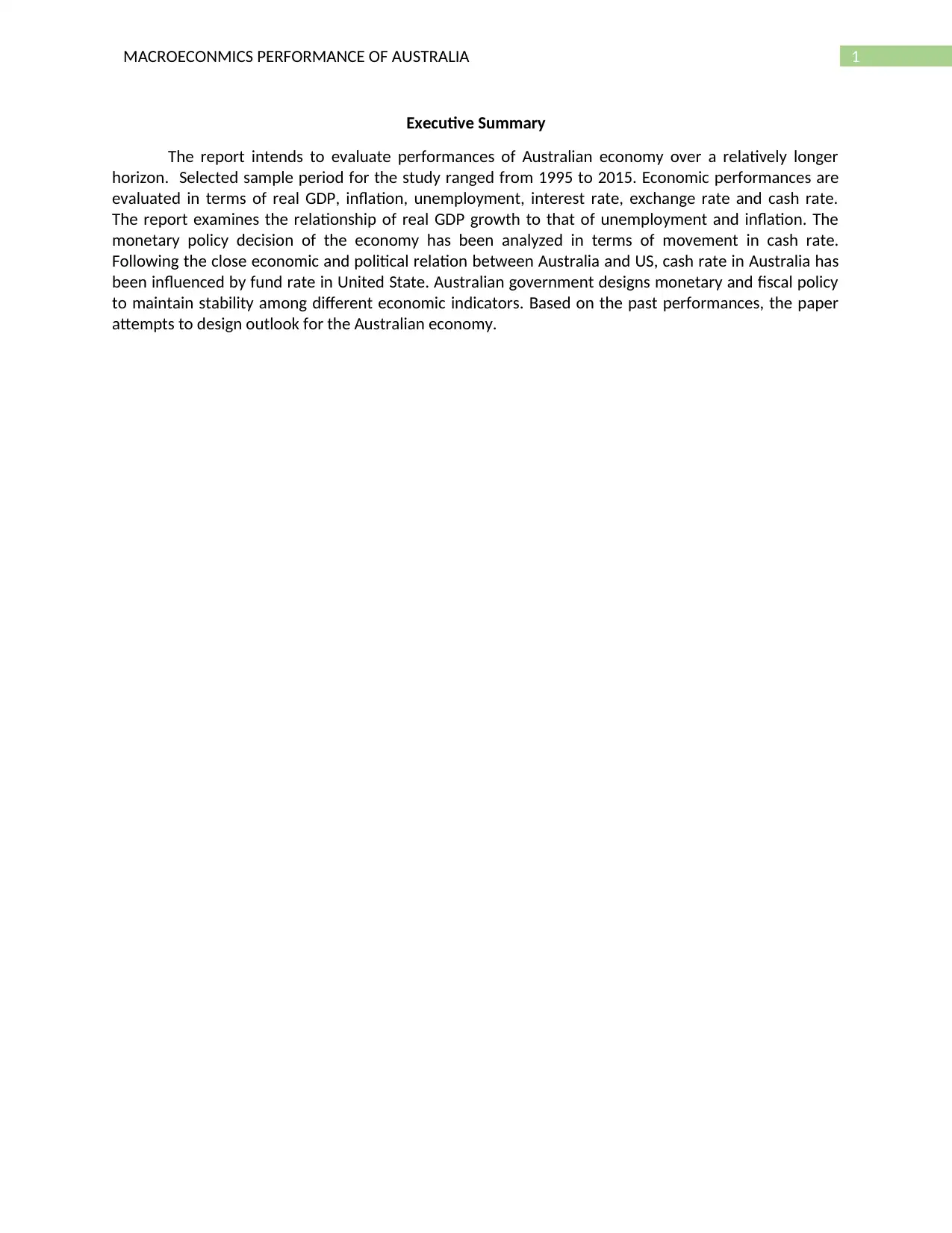
1MACROECONMICS PERFORMANCE OF AUSTRALIA
Executive Summary
The report intends to evaluate performances of Australian economy over a relatively longer
horizon. Selected sample period for the study ranged from 1995 to 2015. Economic performances are
evaluated in terms of real GDP, inflation, unemployment, interest rate, exchange rate and cash rate.
The report examines the relationship of real GDP growth to that of unemployment and inflation. The
monetary policy decision of the economy has been analyzed in terms of movement in cash rate.
Following the close economic and political relation between Australia and US, cash rate in Australia has
been influenced by fund rate in United State. Australian government designs monetary and fiscal policy
to maintain stability among different economic indicators. Based on the past performances, the paper
attempts to design outlook for the Australian economy.
Executive Summary
The report intends to evaluate performances of Australian economy over a relatively longer
horizon. Selected sample period for the study ranged from 1995 to 2015. Economic performances are
evaluated in terms of real GDP, inflation, unemployment, interest rate, exchange rate and cash rate.
The report examines the relationship of real GDP growth to that of unemployment and inflation. The
monetary policy decision of the economy has been analyzed in terms of movement in cash rate.
Following the close economic and political relation between Australia and US, cash rate in Australia has
been influenced by fund rate in United State. Australian government designs monetary and fiscal policy
to maintain stability among different economic indicators. Based on the past performances, the paper
attempts to design outlook for the Australian economy.
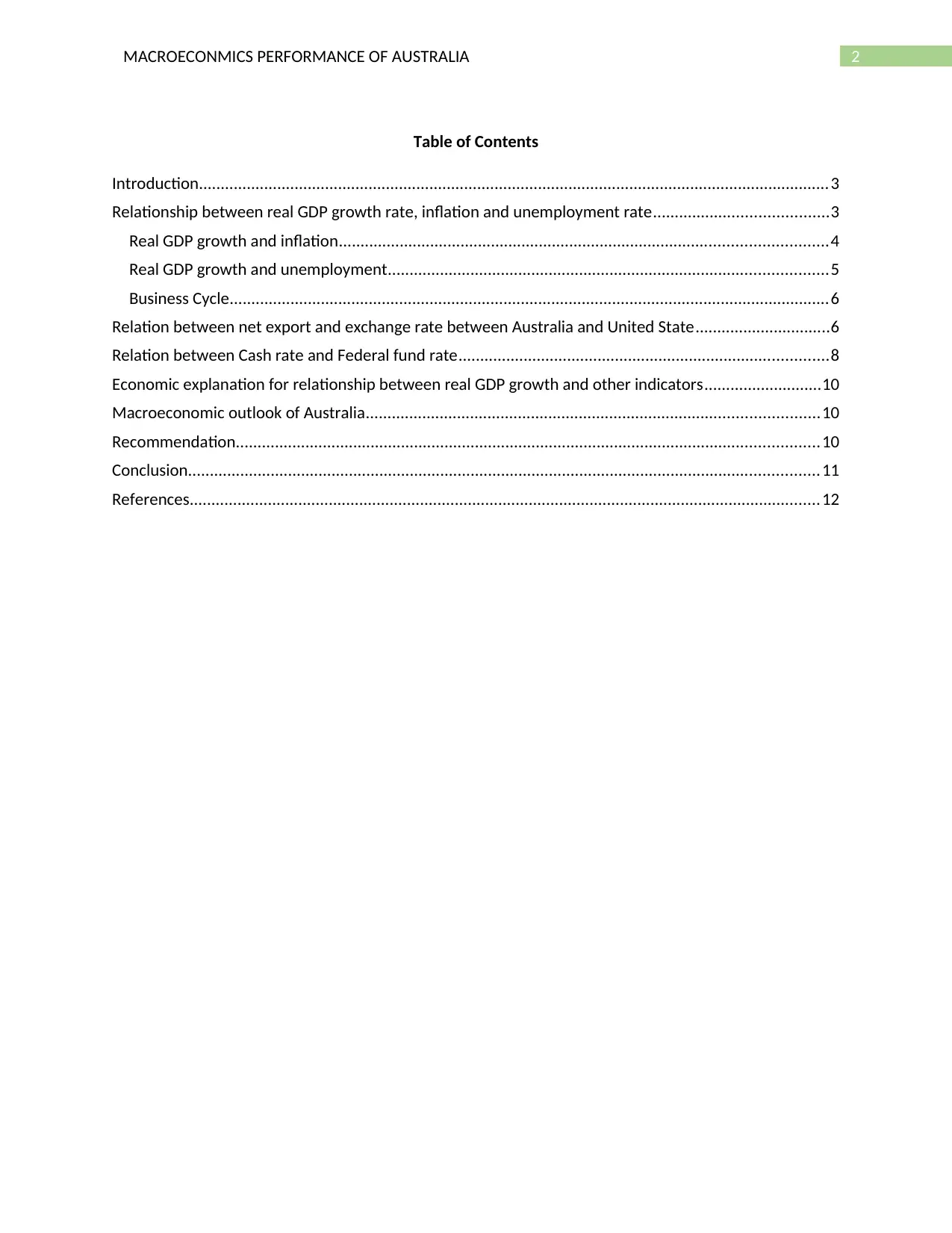
2MACROECONMICS PERFORMANCE OF AUSTRALIA
Table of Contents
Introduction.................................................................................................................................................3
Relationship between real GDP growth rate, inflation and unemployment rate........................................3
Real GDP growth and inflation................................................................................................................4
Real GDP growth and unemployment.....................................................................................................5
Business Cycle..........................................................................................................................................6
Relation between net export and exchange rate between Australia and United State...............................6
Relation between Cash rate and Federal fund rate.....................................................................................8
Economic explanation for relationship between real GDP growth and other indicators...........................10
Macroeconomic outlook of Australia........................................................................................................10
Recommendation......................................................................................................................................10
Conclusion.................................................................................................................................................11
References.................................................................................................................................................12
Table of Contents
Introduction.................................................................................................................................................3
Relationship between real GDP growth rate, inflation and unemployment rate........................................3
Real GDP growth and inflation................................................................................................................4
Real GDP growth and unemployment.....................................................................................................5
Business Cycle..........................................................................................................................................6
Relation between net export and exchange rate between Australia and United State...............................6
Relation between Cash rate and Federal fund rate.....................................................................................8
Economic explanation for relationship between real GDP growth and other indicators...........................10
Macroeconomic outlook of Australia........................................................................................................10
Recommendation......................................................................................................................................10
Conclusion.................................................................................................................................................11
References.................................................................................................................................................12
⊘ This is a preview!⊘
Do you want full access?
Subscribe today to unlock all pages.

Trusted by 1+ million students worldwide

3MACROECONMICS PERFORMANCE OF AUSTRALIA
Introduction
Macroeconomic performance of a nation depends on performance trend of several important
aggregate indicators. Some important indicators for measuring economic performances include
aggregate output, unemployment, price level, trade balance or net export, strength of the currency and
such others. Aggregate output of a nation is measured in terms of Gross Domestic Product. Real GDP is
an inflation-adjusted measure of aggregate output involving estimation using a fixed base year (Heijdra,
2017). Measure of unemployment is used to understand the condition of labor market. Movement of
price level can be understood by observing the trend in inflation rate. Movement of exchange rate and
net export are the two important determinants of stability in the external sector.
Australia one of developed nations that has made outstanding economic progress within a
relatively small period. Service sector is the most important sector of the economy. Another important
sector providing huge support to the economy is mining (Measham, et al., 2013, pp.184-194). The large
stock of mineral resources is the backbone of the mining. Australia is an open economy that largely
depend on trade for its economic growth. The report briefly discusses macroeconomic performance of
Australia from 1995 to 2015 using different indicators such as real GDP growth, inflation,
unemployment, interest rate, exchange rate and net export.
Relationship between real GDP growth rate, inflation and unemployment rate
An important macroeconomic indicator for identifying trend in aggregate output is the gross
domestic product of the nation. GDP refers to a composite measure estimating monetary value of goods
and services that a nation produces in a given year. Values of goods and services are determined by
valuing each items in terms of the market price of the respective goods and services. If goods and
services are valued at current year market prices, then it is called nominal GDP (Agenor and Montiel,
2015). GDP obtained through valuing goods and services using market price of fixed base year is termed
as real GDP. Now, growth in real GDP is the rate of change in real GDP over time. Being a measure of
aggregate economic output, growth in GDP is expected to have a relation with other economic
indicators. Two such indicators are rate of inflation and unemployment rate. An increase in real GDP
indicates progress in economic activity. As GDP increase, average income increases, which causes an
increase in aggregate demand resulting in demand-pull inflation. Inflation resulted from supply side
factor in contrast causes aggregate output to fall by increasing cost of production. Unemployment,
which measure the performance of labor market, is also influenced by GDP (Sadat, 2017, pp.635-639).
An increase in GDP implies expansion of economic activity, which in turn lower unemployment by
creating new job opportunities. Unemployment in contrast increase during economic slow-down.
Introduction
Macroeconomic performance of a nation depends on performance trend of several important
aggregate indicators. Some important indicators for measuring economic performances include
aggregate output, unemployment, price level, trade balance or net export, strength of the currency and
such others. Aggregate output of a nation is measured in terms of Gross Domestic Product. Real GDP is
an inflation-adjusted measure of aggregate output involving estimation using a fixed base year (Heijdra,
2017). Measure of unemployment is used to understand the condition of labor market. Movement of
price level can be understood by observing the trend in inflation rate. Movement of exchange rate and
net export are the two important determinants of stability in the external sector.
Australia one of developed nations that has made outstanding economic progress within a
relatively small period. Service sector is the most important sector of the economy. Another important
sector providing huge support to the economy is mining (Measham, et al., 2013, pp.184-194). The large
stock of mineral resources is the backbone of the mining. Australia is an open economy that largely
depend on trade for its economic growth. The report briefly discusses macroeconomic performance of
Australia from 1995 to 2015 using different indicators such as real GDP growth, inflation,
unemployment, interest rate, exchange rate and net export.
Relationship between real GDP growth rate, inflation and unemployment rate
An important macroeconomic indicator for identifying trend in aggregate output is the gross
domestic product of the nation. GDP refers to a composite measure estimating monetary value of goods
and services that a nation produces in a given year. Values of goods and services are determined by
valuing each items in terms of the market price of the respective goods and services. If goods and
services are valued at current year market prices, then it is called nominal GDP (Agenor and Montiel,
2015). GDP obtained through valuing goods and services using market price of fixed base year is termed
as real GDP. Now, growth in real GDP is the rate of change in real GDP over time. Being a measure of
aggregate economic output, growth in GDP is expected to have a relation with other economic
indicators. Two such indicators are rate of inflation and unemployment rate. An increase in real GDP
indicates progress in economic activity. As GDP increase, average income increases, which causes an
increase in aggregate demand resulting in demand-pull inflation. Inflation resulted from supply side
factor in contrast causes aggregate output to fall by increasing cost of production. Unemployment,
which measure the performance of labor market, is also influenced by GDP (Sadat, 2017, pp.635-639).
An increase in GDP implies expansion of economic activity, which in turn lower unemployment by
creating new job opportunities. Unemployment in contrast increase during economic slow-down.
Paraphrase This Document
Need a fresh take? Get an instant paraphrase of this document with our AI Paraphraser
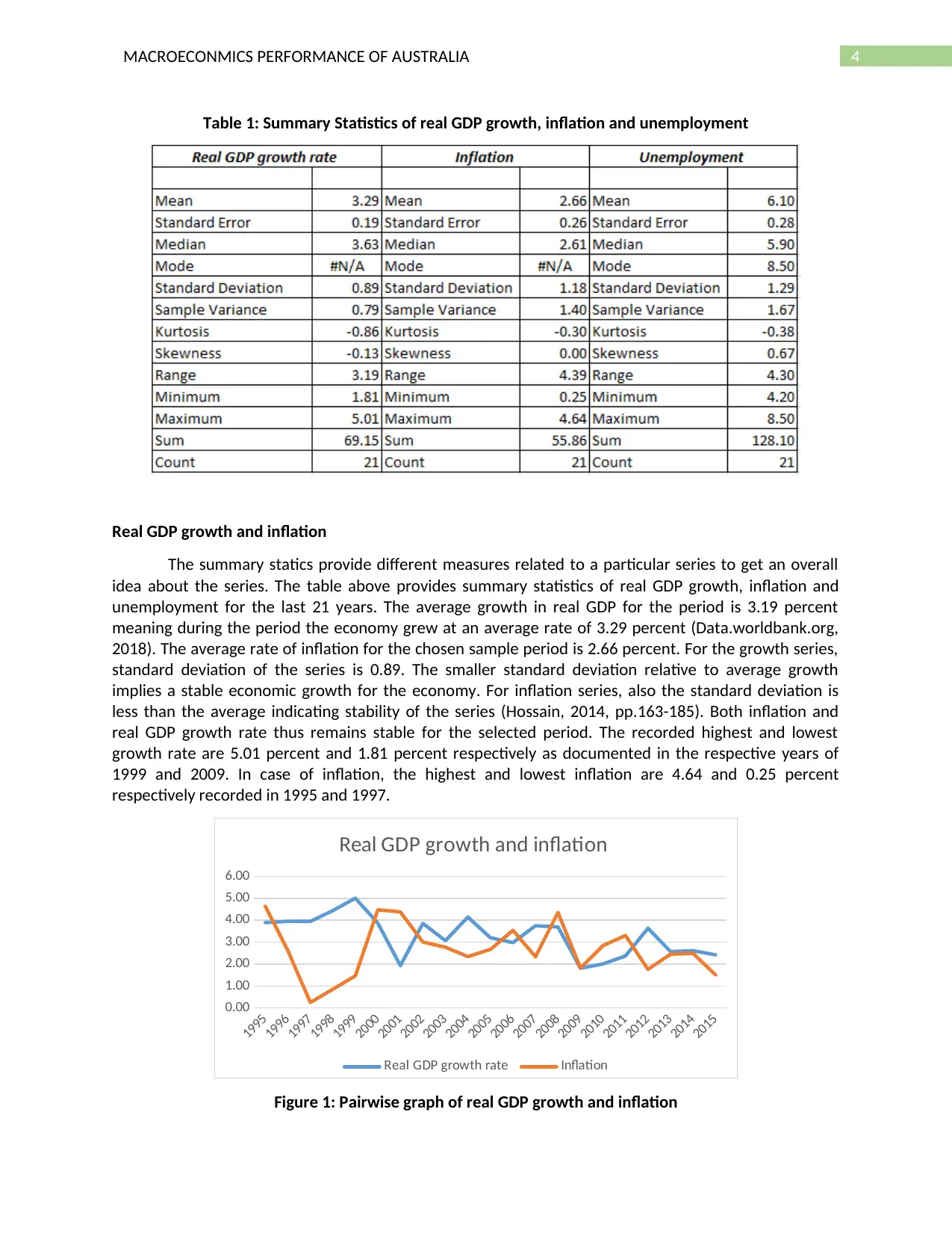
4MACROECONMICS PERFORMANCE OF AUSTRALIA
Table 1: Summary Statistics of real GDP growth, inflation and unemployment
Real GDP growth and inflation
The summary statics provide different measures related to a particular series to get an overall
idea about the series. The table above provides summary statistics of real GDP growth, inflation and
unemployment for the last 21 years. The average growth in real GDP for the period is 3.19 percent
meaning during the period the economy grew at an average rate of 3.29 percent (Data.worldbank.org,
2018). The average rate of inflation for the chosen sample period is 2.66 percent. For the growth series,
standard deviation of the series is 0.89. The smaller standard deviation relative to average growth
implies a stable economic growth for the economy. For inflation series, also the standard deviation is
less than the average indicating stability of the series (Hossain, 2014, pp.163-185). Both inflation and
real GDP growth rate thus remains stable for the selected period. The recorded highest and lowest
growth rate are 5.01 percent and 1.81 percent respectively as documented in the respective years of
1999 and 2009. In case of inflation, the highest and lowest inflation are 4.64 and 0.25 percent
respectively recorded in 1995 and 1997.
1995
1996
1997
1998
1999
2000
2001
2002
2003
2004
2005
2006
2007
2008
2009
2010
2011
2012
2013
2014
2015
0.00
1.00
2.00
3.00
4.00
5.00
6.00
Real GDP growth and inflation
Real GDP growth rate Inflation
Figure 1: Pairwise graph of real GDP growth and inflation
Table 1: Summary Statistics of real GDP growth, inflation and unemployment
Real GDP growth and inflation
The summary statics provide different measures related to a particular series to get an overall
idea about the series. The table above provides summary statistics of real GDP growth, inflation and
unemployment for the last 21 years. The average growth in real GDP for the period is 3.19 percent
meaning during the period the economy grew at an average rate of 3.29 percent (Data.worldbank.org,
2018). The average rate of inflation for the chosen sample period is 2.66 percent. For the growth series,
standard deviation of the series is 0.89. The smaller standard deviation relative to average growth
implies a stable economic growth for the economy. For inflation series, also the standard deviation is
less than the average indicating stability of the series (Hossain, 2014, pp.163-185). Both inflation and
real GDP growth rate thus remains stable for the selected period. The recorded highest and lowest
growth rate are 5.01 percent and 1.81 percent respectively as documented in the respective years of
1999 and 2009. In case of inflation, the highest and lowest inflation are 4.64 and 0.25 percent
respectively recorded in 1995 and 1997.
1995
1996
1997
1998
1999
2000
2001
2002
2003
2004
2005
2006
2007
2008
2009
2010
2011
2012
2013
2014
2015
0.00
1.00
2.00
3.00
4.00
5.00
6.00
Real GDP growth and inflation
Real GDP growth rate Inflation
Figure 1: Pairwise graph of real GDP growth and inflation
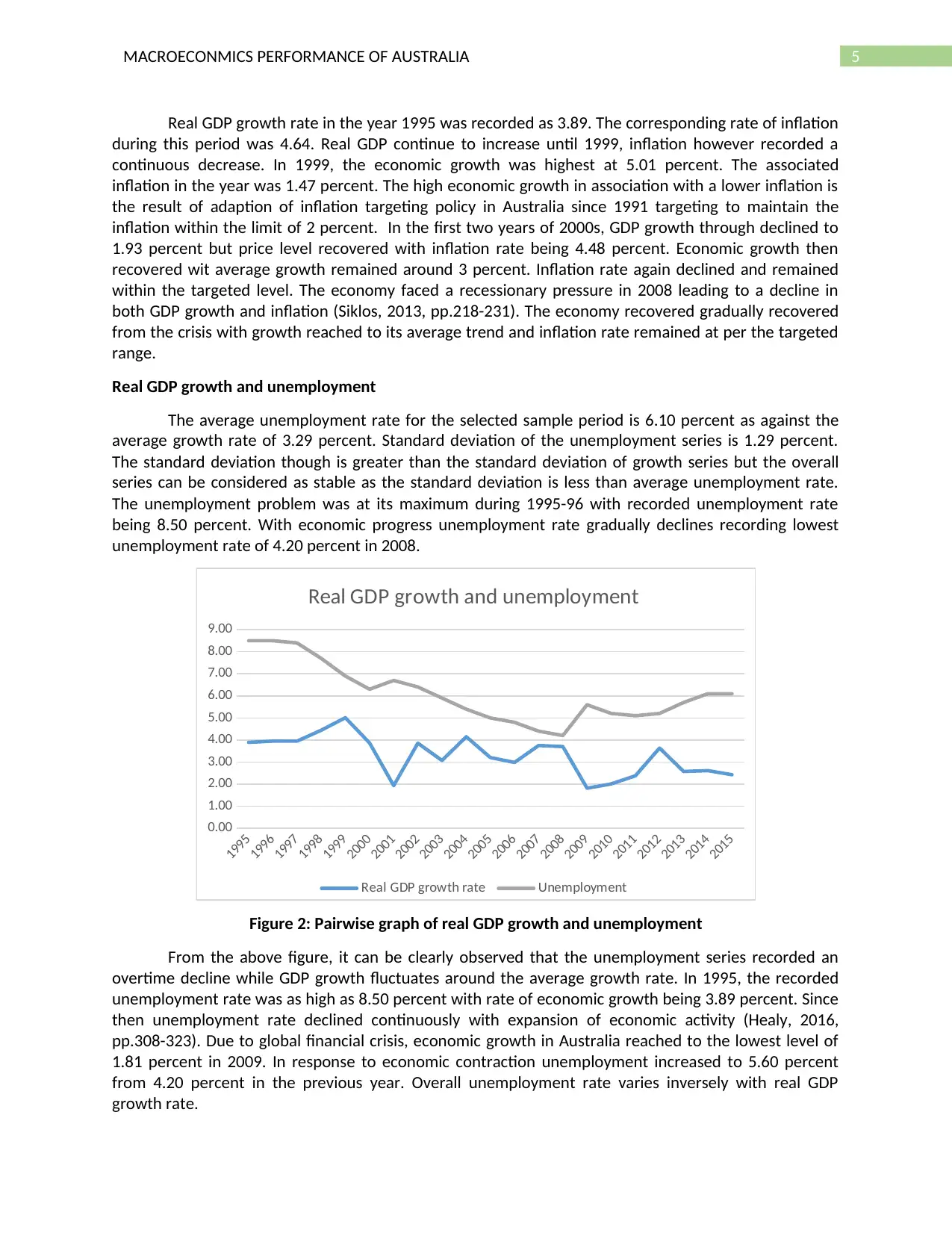
5MACROECONMICS PERFORMANCE OF AUSTRALIA
Real GDP growth rate in the year 1995 was recorded as 3.89. The corresponding rate of inflation
during this period was 4.64. Real GDP continue to increase until 1999, inflation however recorded a
continuous decrease. In 1999, the economic growth was highest at 5.01 percent. The associated
inflation in the year was 1.47 percent. The high economic growth in association with a lower inflation is
the result of adaption of inflation targeting policy in Australia since 1991 targeting to maintain the
inflation within the limit of 2 percent. In the first two years of 2000s, GDP growth through declined to
1.93 percent but price level recovered with inflation rate being 4.48 percent. Economic growth then
recovered wit average growth remained around 3 percent. Inflation rate again declined and remained
within the targeted level. The economy faced a recessionary pressure in 2008 leading to a decline in
both GDP growth and inflation (Siklos, 2013, pp.218-231). The economy recovered gradually recovered
from the crisis with growth reached to its average trend and inflation rate remained at per the targeted
range.
Real GDP growth and unemployment
The average unemployment rate for the selected sample period is 6.10 percent as against the
average growth rate of 3.29 percent. Standard deviation of the unemployment series is 1.29 percent.
The standard deviation though is greater than the standard deviation of growth series but the overall
series can be considered as stable as the standard deviation is less than average unemployment rate.
The unemployment problem was at its maximum during 1995-96 with recorded unemployment rate
being 8.50 percent. With economic progress unemployment rate gradually declines recording lowest
unemployment rate of 4.20 percent in 2008.
1995
1996
1997
1998
1999
2000
2001
2002
2003
2004
2005
2006
2007
2008
2009
2010
2011
2012
2013
2014
2015
0.00
1.00
2.00
3.00
4.00
5.00
6.00
7.00
8.00
9.00
Real GDP growth and unemployment
Real GDP growth rate Unemployment
Figure 2: Pairwise graph of real GDP growth and unemployment
From the above figure, it can be clearly observed that the unemployment series recorded an
overtime decline while GDP growth fluctuates around the average growth rate. In 1995, the recorded
unemployment rate was as high as 8.50 percent with rate of economic growth being 3.89 percent. Since
then unemployment rate declined continuously with expansion of economic activity (Healy, 2016,
pp.308-323). Due to global financial crisis, economic growth in Australia reached to the lowest level of
1.81 percent in 2009. In response to economic contraction unemployment increased to 5.60 percent
from 4.20 percent in the previous year. Overall unemployment rate varies inversely with real GDP
growth rate.
Real GDP growth rate in the year 1995 was recorded as 3.89. The corresponding rate of inflation
during this period was 4.64. Real GDP continue to increase until 1999, inflation however recorded a
continuous decrease. In 1999, the economic growth was highest at 5.01 percent. The associated
inflation in the year was 1.47 percent. The high economic growth in association with a lower inflation is
the result of adaption of inflation targeting policy in Australia since 1991 targeting to maintain the
inflation within the limit of 2 percent. In the first two years of 2000s, GDP growth through declined to
1.93 percent but price level recovered with inflation rate being 4.48 percent. Economic growth then
recovered wit average growth remained around 3 percent. Inflation rate again declined and remained
within the targeted level. The economy faced a recessionary pressure in 2008 leading to a decline in
both GDP growth and inflation (Siklos, 2013, pp.218-231). The economy recovered gradually recovered
from the crisis with growth reached to its average trend and inflation rate remained at per the targeted
range.
Real GDP growth and unemployment
The average unemployment rate for the selected sample period is 6.10 percent as against the
average growth rate of 3.29 percent. Standard deviation of the unemployment series is 1.29 percent.
The standard deviation though is greater than the standard deviation of growth series but the overall
series can be considered as stable as the standard deviation is less than average unemployment rate.
The unemployment problem was at its maximum during 1995-96 with recorded unemployment rate
being 8.50 percent. With economic progress unemployment rate gradually declines recording lowest
unemployment rate of 4.20 percent in 2008.
1995
1996
1997
1998
1999
2000
2001
2002
2003
2004
2005
2006
2007
2008
2009
2010
2011
2012
2013
2014
2015
0.00
1.00
2.00
3.00
4.00
5.00
6.00
7.00
8.00
9.00
Real GDP growth and unemployment
Real GDP growth rate Unemployment
Figure 2: Pairwise graph of real GDP growth and unemployment
From the above figure, it can be clearly observed that the unemployment series recorded an
overtime decline while GDP growth fluctuates around the average growth rate. In 1995, the recorded
unemployment rate was as high as 8.50 percent with rate of economic growth being 3.89 percent. Since
then unemployment rate declined continuously with expansion of economic activity (Healy, 2016,
pp.308-323). Due to global financial crisis, economic growth in Australia reached to the lowest level of
1.81 percent in 2009. In response to economic contraction unemployment increased to 5.60 percent
from 4.20 percent in the previous year. Overall unemployment rate varies inversely with real GDP
growth rate.
⊘ This is a preview!⊘
Do you want full access?
Subscribe today to unlock all pages.

Trusted by 1+ million students worldwide

6MACROECONMICS PERFORMANCE OF AUSTRALIA
Paraphrase This Document
Need a fresh take? Get an instant paraphrase of this document with our AI Paraphraser
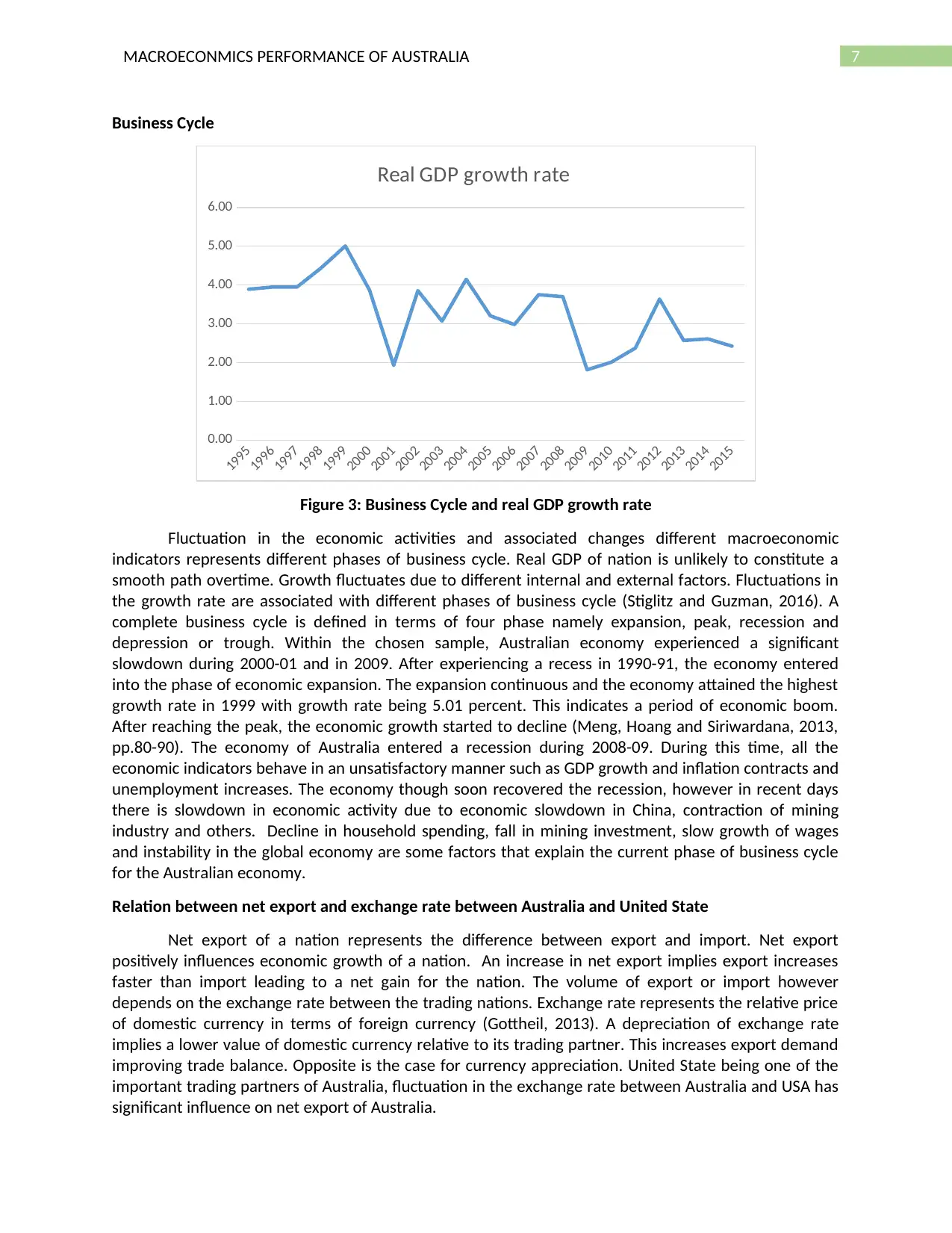
7MACROECONMICS PERFORMANCE OF AUSTRALIA
Business Cycle
1995
1996
1997
1998
1999
2000
2001
2002
2003
2004
2005
2006
2007
2008
2009
2010
2011
2012
2013
2014
2015
0.00
1.00
2.00
3.00
4.00
5.00
6.00
Real GDP growth rate
Figure 3: Business Cycle and real GDP growth rate
Fluctuation in the economic activities and associated changes different macroeconomic
indicators represents different phases of business cycle. Real GDP of nation is unlikely to constitute a
smooth path overtime. Growth fluctuates due to different internal and external factors. Fluctuations in
the growth rate are associated with different phases of business cycle (Stiglitz and Guzman, 2016). A
complete business cycle is defined in terms of four phase namely expansion, peak, recession and
depression or trough. Within the chosen sample, Australian economy experienced a significant
slowdown during 2000-01 and in 2009. After experiencing a recess in 1990-91, the economy entered
into the phase of economic expansion. The expansion continuous and the economy attained the highest
growth rate in 1999 with growth rate being 5.01 percent. This indicates a period of economic boom.
After reaching the peak, the economic growth started to decline (Meng, Hoang and Siriwardana, 2013,
pp.80-90). The economy of Australia entered a recession during 2008-09. During this time, all the
economic indicators behave in an unsatisfactory manner such as GDP growth and inflation contracts and
unemployment increases. The economy though soon recovered the recession, however in recent days
there is slowdown in economic activity due to economic slowdown in China, contraction of mining
industry and others. Decline in household spending, fall in mining investment, slow growth of wages
and instability in the global economy are some factors that explain the current phase of business cycle
for the Australian economy.
Relation between net export and exchange rate between Australia and United State
Net export of a nation represents the difference between export and import. Net export
positively influences economic growth of a nation. An increase in net export implies export increases
faster than import leading to a net gain for the nation. The volume of export or import however
depends on the exchange rate between the trading nations. Exchange rate represents the relative price
of domestic currency in terms of foreign currency (Gottheil, 2013). A depreciation of exchange rate
implies a lower value of domestic currency relative to its trading partner. This increases export demand
improving trade balance. Opposite is the case for currency appreciation. United State being one of the
important trading partners of Australia, fluctuation in the exchange rate between Australia and USA has
significant influence on net export of Australia.
Business Cycle
1995
1996
1997
1998
1999
2000
2001
2002
2003
2004
2005
2006
2007
2008
2009
2010
2011
2012
2013
2014
2015
0.00
1.00
2.00
3.00
4.00
5.00
6.00
Real GDP growth rate
Figure 3: Business Cycle and real GDP growth rate
Fluctuation in the economic activities and associated changes different macroeconomic
indicators represents different phases of business cycle. Real GDP of nation is unlikely to constitute a
smooth path overtime. Growth fluctuates due to different internal and external factors. Fluctuations in
the growth rate are associated with different phases of business cycle (Stiglitz and Guzman, 2016). A
complete business cycle is defined in terms of four phase namely expansion, peak, recession and
depression or trough. Within the chosen sample, Australian economy experienced a significant
slowdown during 2000-01 and in 2009. After experiencing a recess in 1990-91, the economy entered
into the phase of economic expansion. The expansion continuous and the economy attained the highest
growth rate in 1999 with growth rate being 5.01 percent. This indicates a period of economic boom.
After reaching the peak, the economic growth started to decline (Meng, Hoang and Siriwardana, 2013,
pp.80-90). The economy of Australia entered a recession during 2008-09. During this time, all the
economic indicators behave in an unsatisfactory manner such as GDP growth and inflation contracts and
unemployment increases. The economy though soon recovered the recession, however in recent days
there is slowdown in economic activity due to economic slowdown in China, contraction of mining
industry and others. Decline in household spending, fall in mining investment, slow growth of wages
and instability in the global economy are some factors that explain the current phase of business cycle
for the Australian economy.
Relation between net export and exchange rate between Australia and United State
Net export of a nation represents the difference between export and import. Net export
positively influences economic growth of a nation. An increase in net export implies export increases
faster than import leading to a net gain for the nation. The volume of export or import however
depends on the exchange rate between the trading nations. Exchange rate represents the relative price
of domestic currency in terms of foreign currency (Gottheil, 2013). A depreciation of exchange rate
implies a lower value of domestic currency relative to its trading partner. This increases export demand
improving trade balance. Opposite is the case for currency appreciation. United State being one of the
important trading partners of Australia, fluctuation in the exchange rate between Australia and USA has
significant influence on net export of Australia.
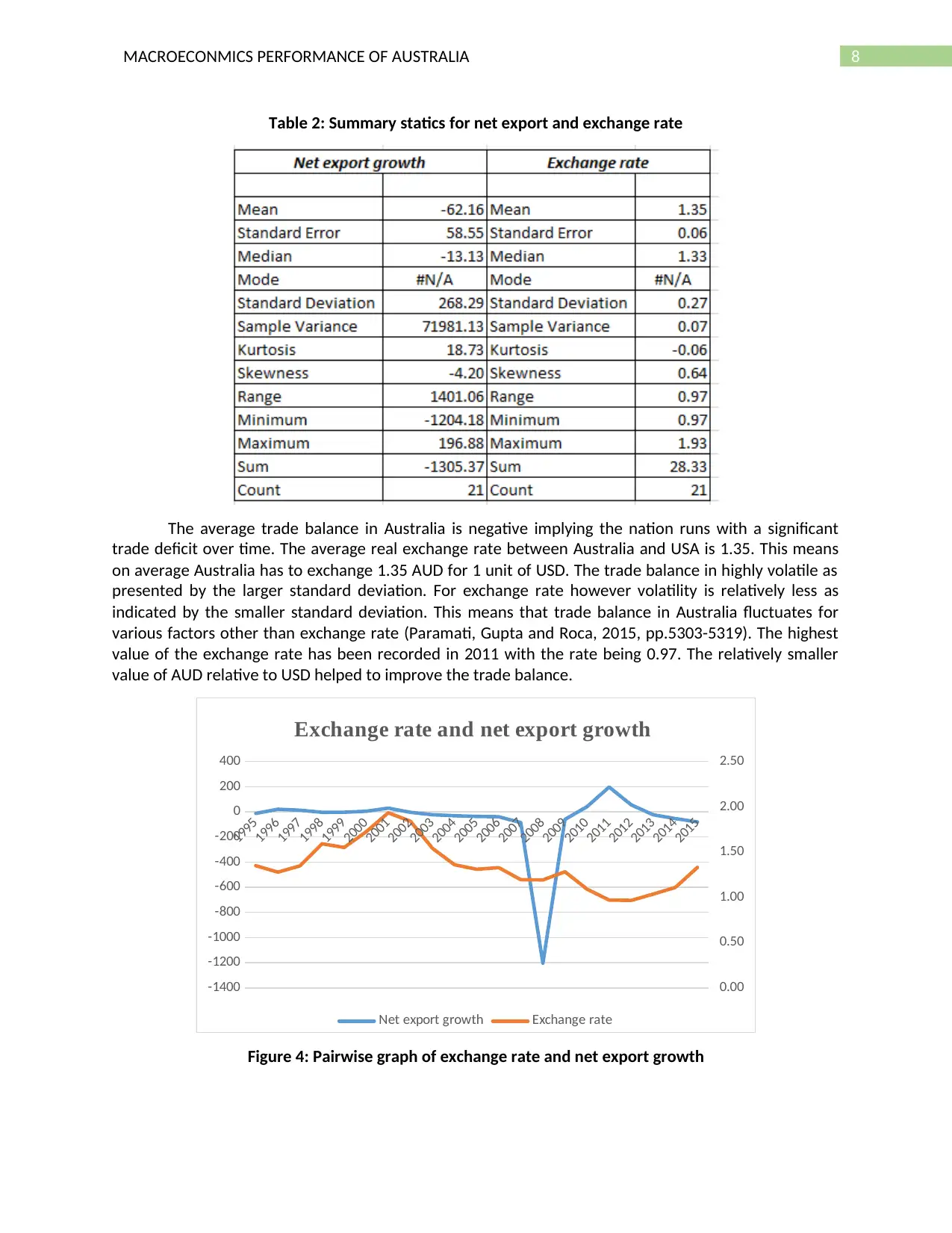
8MACROECONMICS PERFORMANCE OF AUSTRALIA
Table 2: Summary statics for net export and exchange rate
The average trade balance in Australia is negative implying the nation runs with a significant
trade deficit over time. The average real exchange rate between Australia and USA is 1.35. This means
on average Australia has to exchange 1.35 AUD for 1 unit of USD. The trade balance in highly volatile as
presented by the larger standard deviation. For exchange rate however volatility is relatively less as
indicated by the smaller standard deviation. This means that trade balance in Australia fluctuates for
various factors other than exchange rate (Paramati, Gupta and Roca, 2015, pp.5303-5319). The highest
value of the exchange rate has been recorded in 2011 with the rate being 0.97. The relatively smaller
value of AUD relative to USD helped to improve the trade balance.
1995
1996
1997
1998
1999
2000
2001
2002
2003
2004
2005
2006
2007
2008
2009
2010
2011
2012
2013
2014
2015
-1400
-1200
-1000
-800
-600
-400
-200
0
200
400
0.00
0.50
1.00
1.50
2.00
2.50
Exchange rate and net export growth
Net export growth Exchange rate
Figure 4: Pairwise graph of exchange rate and net export growth
Table 2: Summary statics for net export and exchange rate
The average trade balance in Australia is negative implying the nation runs with a significant
trade deficit over time. The average real exchange rate between Australia and USA is 1.35. This means
on average Australia has to exchange 1.35 AUD for 1 unit of USD. The trade balance in highly volatile as
presented by the larger standard deviation. For exchange rate however volatility is relatively less as
indicated by the smaller standard deviation. This means that trade balance in Australia fluctuates for
various factors other than exchange rate (Paramati, Gupta and Roca, 2015, pp.5303-5319). The highest
value of the exchange rate has been recorded in 2011 with the rate being 0.97. The relatively smaller
value of AUD relative to USD helped to improve the trade balance.
1995
1996
1997
1998
1999
2000
2001
2002
2003
2004
2005
2006
2007
2008
2009
2010
2011
2012
2013
2014
2015
-1400
-1200
-1000
-800
-600
-400
-200
0
200
400
0.00
0.50
1.00
1.50
2.00
2.50
Exchange rate and net export growth
Net export growth Exchange rate
Figure 4: Pairwise graph of exchange rate and net export growth
⊘ This is a preview!⊘
Do you want full access?
Subscribe today to unlock all pages.

Trusted by 1+ million students worldwide

9MACROECONMICS PERFORMANCE OF AUSTRALIA
The exchange rate in 1995 was 1.35. Net export in this year was positive. Exchange rate
declined to 1.28. The decline in exchange rate increase export demand of Australia increasing trade
balance of the nation. Since then, net export increases with depreciation of exchange rate and trade
balance declines following appreciation of exchange rate (rba.gov.au, 2018). During global financial
crisis, the economy experienced considerably large trade deficit. The lowest value of Australian dollar
against the USD was 0.97 in 2011. The smaller exchange rate helped Australia to recover the trade
balance. After that, an increase in value of exchange rate again led to a negative trade balance (Manalo,
Perera, and Rees, 2015, pp.53-62). Overall, net export of Australia is moving in the opposite direction of
exchange rate as stated by standard theory.
Relation between Cash rate and Federal fund rate
Cash rate and fund rate both are monetary policy instrument used in Australia and United State
respectively. These denote the overnight rate at which the respective central banks in both the nation
lend money to other banks in the nation. Reserve bank of Australia determines the cash rate while
Federal Reserve determines the fund rate (Johnson, 2017). In time of higher inflation, central bank
increases the bank rate to tighten economic spending. During economic contraction in contrast, the
central bank lowers the rate to stimulate economic activity. The monetary policy decision in one nation
affects the policy decision in other decision. For example, if Fed increase fund rate, then investors
withdraw funds from Australia and invest in United State lowering the value of Australian dollar in the
international market. In order to maintain stability in the exchange rate, RBA then also increases the
cash rate.
The exchange rate in 1995 was 1.35. Net export in this year was positive. Exchange rate
declined to 1.28. The decline in exchange rate increase export demand of Australia increasing trade
balance of the nation. Since then, net export increases with depreciation of exchange rate and trade
balance declines following appreciation of exchange rate (rba.gov.au, 2018). During global financial
crisis, the economy experienced considerably large trade deficit. The lowest value of Australian dollar
against the USD was 0.97 in 2011. The smaller exchange rate helped Australia to recover the trade
balance. After that, an increase in value of exchange rate again led to a negative trade balance (Manalo,
Perera, and Rees, 2015, pp.53-62). Overall, net export of Australia is moving in the opposite direction of
exchange rate as stated by standard theory.
Relation between Cash rate and Federal fund rate
Cash rate and fund rate both are monetary policy instrument used in Australia and United State
respectively. These denote the overnight rate at which the respective central banks in both the nation
lend money to other banks in the nation. Reserve bank of Australia determines the cash rate while
Federal Reserve determines the fund rate (Johnson, 2017). In time of higher inflation, central bank
increases the bank rate to tighten economic spending. During economic contraction in contrast, the
central bank lowers the rate to stimulate economic activity. The monetary policy decision in one nation
affects the policy decision in other decision. For example, if Fed increase fund rate, then investors
withdraw funds from Australia and invest in United State lowering the value of Australian dollar in the
international market. In order to maintain stability in the exchange rate, RBA then also increases the
cash rate.
Paraphrase This Document
Need a fresh take? Get an instant paraphrase of this document with our AI Paraphraser
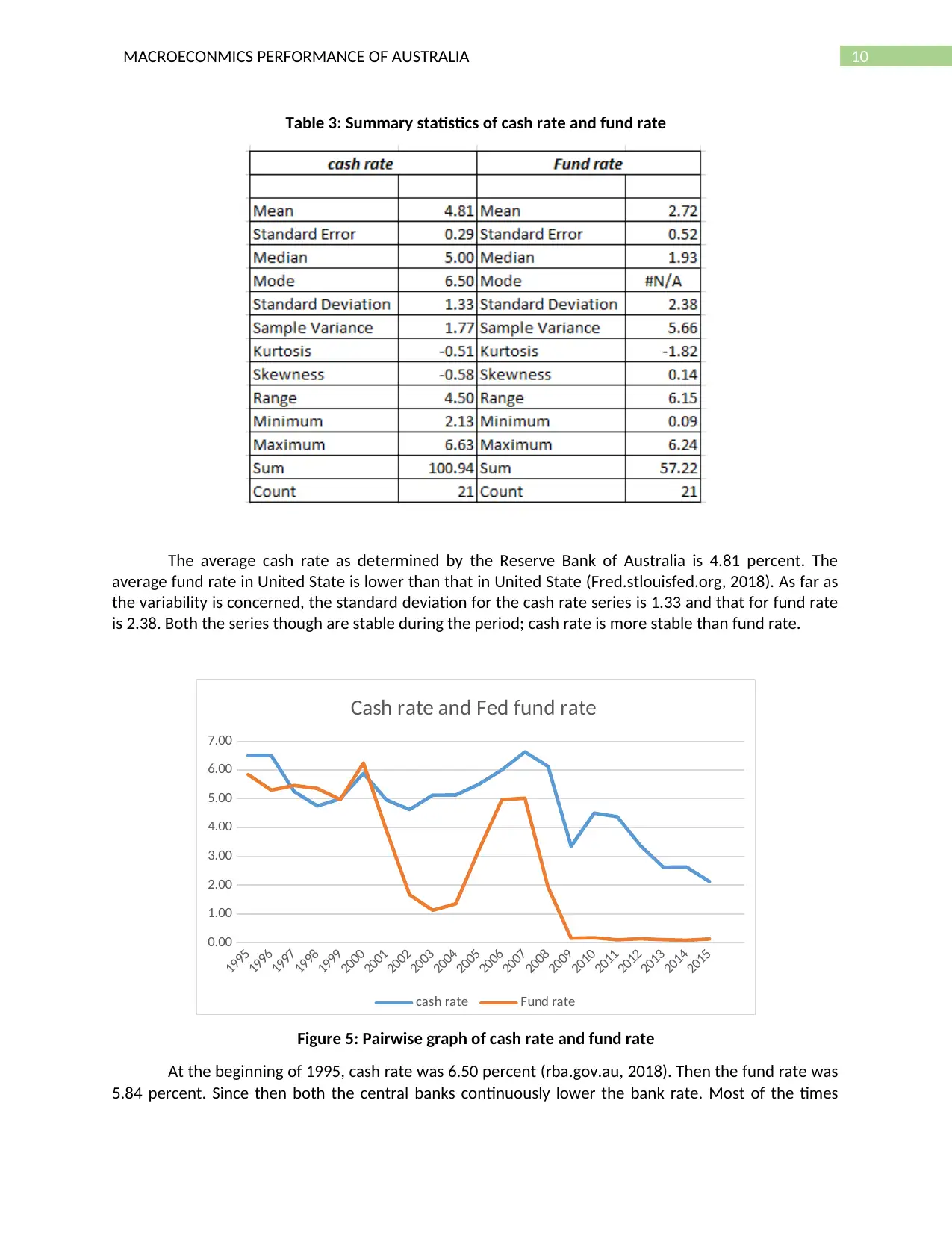
10MACROECONMICS PERFORMANCE OF AUSTRALIA
Table 3: Summary statistics of cash rate and fund rate
The average cash rate as determined by the Reserve Bank of Australia is 4.81 percent. The
average fund rate in United State is lower than that in United State (Fred.stlouisfed.org, 2018). As far as
the variability is concerned, the standard deviation for the cash rate series is 1.33 and that for fund rate
is 2.38. Both the series though are stable during the period; cash rate is more stable than fund rate.
1995
1996
1997
1998
1999
2000
2001
2002
2003
2004
2005
2006
2007
2008
2009
2010
2011
2012
2013
2014
2015
0.00
1.00
2.00
3.00
4.00
5.00
6.00
7.00
Cash rate and Fed fund rate
cash rate Fund rate
Figure 5: Pairwise graph of cash rate and fund rate
At the beginning of 1995, cash rate was 6.50 percent (rba.gov.au, 2018). Then the fund rate was
5.84 percent. Since then both the central banks continuously lower the bank rate. Most of the times
Table 3: Summary statistics of cash rate and fund rate
The average cash rate as determined by the Reserve Bank of Australia is 4.81 percent. The
average fund rate in United State is lower than that in United State (Fred.stlouisfed.org, 2018). As far as
the variability is concerned, the standard deviation for the cash rate series is 1.33 and that for fund rate
is 2.38. Both the series though are stable during the period; cash rate is more stable than fund rate.
1995
1996
1997
1998
1999
2000
2001
2002
2003
2004
2005
2006
2007
2008
2009
2010
2011
2012
2013
2014
2015
0.00
1.00
2.00
3.00
4.00
5.00
6.00
7.00
Cash rate and Fed fund rate
cash rate Fund rate
Figure 5: Pairwise graph of cash rate and fund rate
At the beginning of 1995, cash rate was 6.50 percent (rba.gov.au, 2018). Then the fund rate was
5.84 percent. Since then both the central banks continuously lower the bank rate. Most of the times
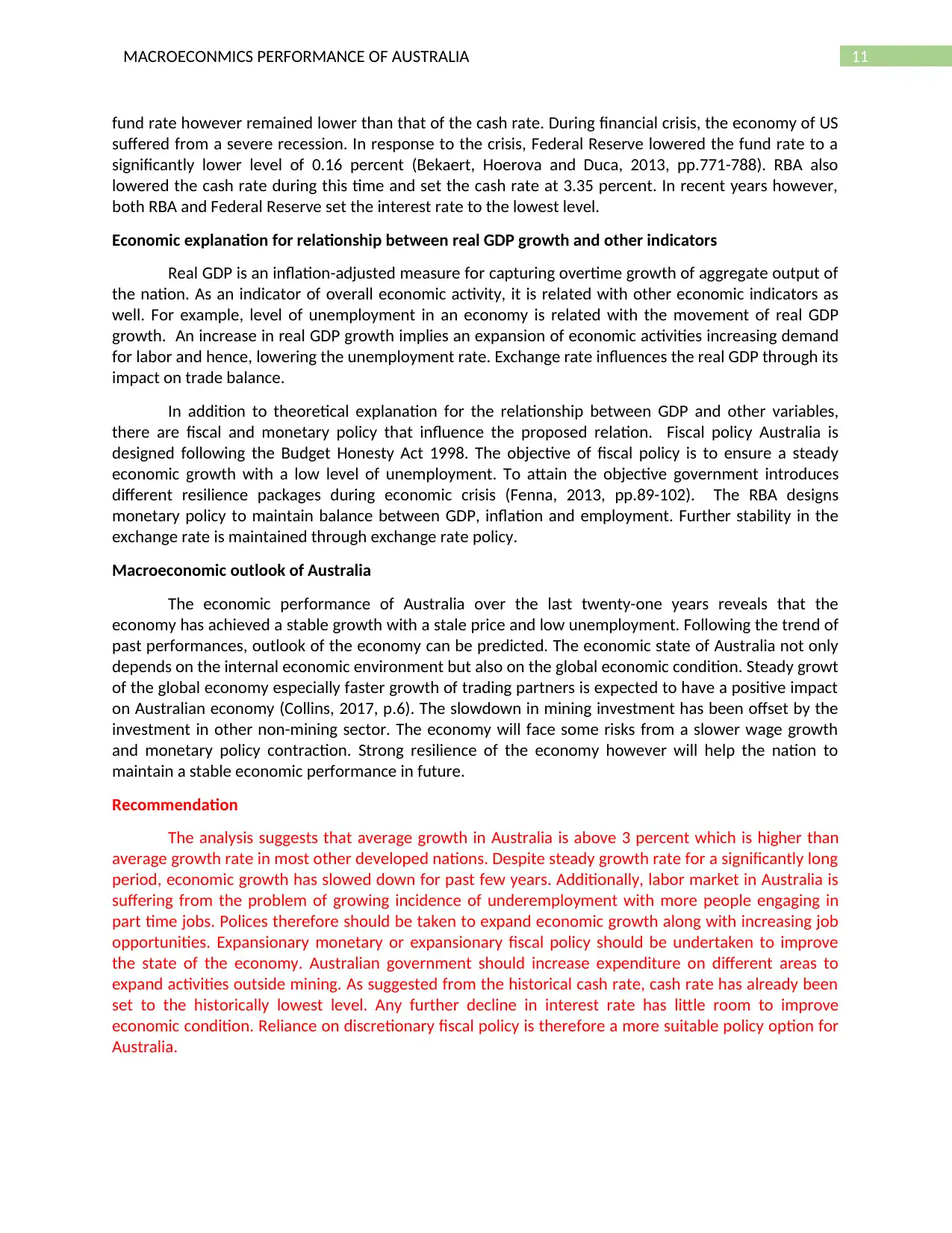
11MACROECONMICS PERFORMANCE OF AUSTRALIA
fund rate however remained lower than that of the cash rate. During financial crisis, the economy of US
suffered from a severe recession. In response to the crisis, Federal Reserve lowered the fund rate to a
significantly lower level of 0.16 percent (Bekaert, Hoerova and Duca, 2013, pp.771-788). RBA also
lowered the cash rate during this time and set the cash rate at 3.35 percent. In recent years however,
both RBA and Federal Reserve set the interest rate to the lowest level.
Economic explanation for relationship between real GDP growth and other indicators
Real GDP is an inflation-adjusted measure for capturing overtime growth of aggregate output of
the nation. As an indicator of overall economic activity, it is related with other economic indicators as
well. For example, level of unemployment in an economy is related with the movement of real GDP
growth. An increase in real GDP growth implies an expansion of economic activities increasing demand
for labor and hence, lowering the unemployment rate. Exchange rate influences the real GDP through its
impact on trade balance.
In addition to theoretical explanation for the relationship between GDP and other variables,
there are fiscal and monetary policy that influence the proposed relation. Fiscal policy Australia is
designed following the Budget Honesty Act 1998. The objective of fiscal policy is to ensure a steady
economic growth with a low level of unemployment. To attain the objective government introduces
different resilience packages during economic crisis (Fenna, 2013, pp.89-102). The RBA designs
monetary policy to maintain balance between GDP, inflation and employment. Further stability in the
exchange rate is maintained through exchange rate policy.
Macroeconomic outlook of Australia
The economic performance of Australia over the last twenty-one years reveals that the
economy has achieved a stable growth with a stale price and low unemployment. Following the trend of
past performances, outlook of the economy can be predicted. The economic state of Australia not only
depends on the internal economic environment but also on the global economic condition. Steady growt
of the global economy especially faster growth of trading partners is expected to have a positive impact
on Australian economy (Collins, 2017, p.6). The slowdown in mining investment has been offset by the
investment in other non-mining sector. The economy will face some risks from a slower wage growth
and monetary policy contraction. Strong resilience of the economy however will help the nation to
maintain a stable economic performance in future.
Recommendation
The analysis suggests that average growth in Australia is above 3 percent which is higher than
average growth rate in most other developed nations. Despite steady growth rate for a significantly long
period, economic growth has slowed down for past few years. Additionally, labor market in Australia is
suffering from the problem of growing incidence of underemployment with more people engaging in
part time jobs. Polices therefore should be taken to expand economic growth along with increasing job
opportunities. Expansionary monetary or expansionary fiscal policy should be undertaken to improve
the state of the economy. Australian government should increase expenditure on different areas to
expand activities outside mining. As suggested from the historical cash rate, cash rate has already been
set to the historically lowest level. Any further decline in interest rate has little room to improve
economic condition. Reliance on discretionary fiscal policy is therefore a more suitable policy option for
Australia.
fund rate however remained lower than that of the cash rate. During financial crisis, the economy of US
suffered from a severe recession. In response to the crisis, Federal Reserve lowered the fund rate to a
significantly lower level of 0.16 percent (Bekaert, Hoerova and Duca, 2013, pp.771-788). RBA also
lowered the cash rate during this time and set the cash rate at 3.35 percent. In recent years however,
both RBA and Federal Reserve set the interest rate to the lowest level.
Economic explanation for relationship between real GDP growth and other indicators
Real GDP is an inflation-adjusted measure for capturing overtime growth of aggregate output of
the nation. As an indicator of overall economic activity, it is related with other economic indicators as
well. For example, level of unemployment in an economy is related with the movement of real GDP
growth. An increase in real GDP growth implies an expansion of economic activities increasing demand
for labor and hence, lowering the unemployment rate. Exchange rate influences the real GDP through its
impact on trade balance.
In addition to theoretical explanation for the relationship between GDP and other variables,
there are fiscal and monetary policy that influence the proposed relation. Fiscal policy Australia is
designed following the Budget Honesty Act 1998. The objective of fiscal policy is to ensure a steady
economic growth with a low level of unemployment. To attain the objective government introduces
different resilience packages during economic crisis (Fenna, 2013, pp.89-102). The RBA designs
monetary policy to maintain balance between GDP, inflation and employment. Further stability in the
exchange rate is maintained through exchange rate policy.
Macroeconomic outlook of Australia
The economic performance of Australia over the last twenty-one years reveals that the
economy has achieved a stable growth with a stale price and low unemployment. Following the trend of
past performances, outlook of the economy can be predicted. The economic state of Australia not only
depends on the internal economic environment but also on the global economic condition. Steady growt
of the global economy especially faster growth of trading partners is expected to have a positive impact
on Australian economy (Collins, 2017, p.6). The slowdown in mining investment has been offset by the
investment in other non-mining sector. The economy will face some risks from a slower wage growth
and monetary policy contraction. Strong resilience of the economy however will help the nation to
maintain a stable economic performance in future.
Recommendation
The analysis suggests that average growth in Australia is above 3 percent which is higher than
average growth rate in most other developed nations. Despite steady growth rate for a significantly long
period, economic growth has slowed down for past few years. Additionally, labor market in Australia is
suffering from the problem of growing incidence of underemployment with more people engaging in
part time jobs. Polices therefore should be taken to expand economic growth along with increasing job
opportunities. Expansionary monetary or expansionary fiscal policy should be undertaken to improve
the state of the economy. Australian government should increase expenditure on different areas to
expand activities outside mining. As suggested from the historical cash rate, cash rate has already been
set to the historically lowest level. Any further decline in interest rate has little room to improve
economic condition. Reliance on discretionary fiscal policy is therefore a more suitable policy option for
Australia.
⊘ This is a preview!⊘
Do you want full access?
Subscribe today to unlock all pages.

Trusted by 1+ million students worldwide
1 out of 14
Related Documents
Your All-in-One AI-Powered Toolkit for Academic Success.
+13062052269
info@desklib.com
Available 24*7 on WhatsApp / Email
![[object Object]](/_next/static/media/star-bottom.7253800d.svg)
Unlock your academic potential
Copyright © 2020–2025 A2Z Services. All Rights Reserved. Developed and managed by ZUCOL.





